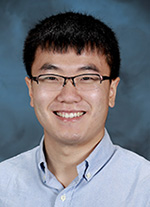New insights on radiation effects in advanced nuclear materials through integrating comprehensive microscopy and simulation
Date: 2022/05/05 - 2022/05/05
Academic Seminar: New insights on radiation effects in advanced nuclear materials through integrating comprehensive microscopy and simulation
Speaker: Dr. Congyi Li, Shanghai Institute of Applied Physics
Time: 1:30 p.m.- 2:30 p.m., May 5th, 2022 ( Beijing Time)
Location: via feishu
Abstract
The required performance parameters for structural materials in the hostile environment of future nuclear power systems are very challenging. Thus, high performance material is needed to ensure safety and reliability of future nuclear power. Recent advances in material design and manufacturing technology open up new opportunities to synthesis novel materials with better radiation tolerance, such as high entropy alloy (HEA) and nanostructured tungsten. However, the complex chemical environment, microstructural features and extreme radiation environment conditions challenges conventional wisdom in radiation material sciences. Development and integration of new models and examination techniques are needed to lay the foundation for understanding unique radiation effects in novel materials and provide new insights in designing radiation resistance in nuclear materials.
In this talk, I will introduce unique radiation-induced material degradation phenomena in future nuclear fission and fusion power systems, and demonstrate my integrative approach combining microscopy and model to study unique radiation effects through three examples: (1) Radiation induced segregation in compositionally complex HEA, (2) vacancy-type defect cluster evolution in neutron irradiated alloy, and (3) synergistic effect of helium and radiation damage in plasma-facing material. Finally, I will discuss the development of nuclear material microscopy and modeling platform, and its potential application in nuclear material as well as other research fields.
Biography
 Dr. Congyi Li currently works at Shanghai Institute of Applied Physics on nuclear material research for Thorium Molten Salt Reactor. He earned dual B.S in Mechanical Engineering from UM-SJTU Joint Insitute (JI), and in Nuclear Engineering and Radiological Sciences from University of Michigan, Ann Arbor. After graduating from JI, he continued to pursed his PhD in Nuclear Engineering at University of Tennessee, Knoxville supervised by Prof. Steven Zinkle, member of National Academy of Engineering. His PhD research focus on combining multi-scale examination and ab initio simulation method to understand unique radiation effects in FeNiMnCr high entropy entropy for advanced nuclear reactor application. After receiving his PhD, he joined Oak Ridge National Laboratory as a postdoc fellow and focused on developing microscopy techniques and modeling tools to study the synergistic effect of helium and radiation damage in divertor materials for fusion energy device. He is the recipient of UT-ORNL energy science and engineering fellowship and was invited as the reviewer for Acta Materialia, Journal of Nuclear Material and Journal of Materials Research.
Dr. Congyi Li currently works at Shanghai Institute of Applied Physics on nuclear material research for Thorium Molten Salt Reactor. He earned dual B.S in Mechanical Engineering from UM-SJTU Joint Insitute (JI), and in Nuclear Engineering and Radiological Sciences from University of Michigan, Ann Arbor. After graduating from JI, he continued to pursed his PhD in Nuclear Engineering at University of Tennessee, Knoxville supervised by Prof. Steven Zinkle, member of National Academy of Engineering. His PhD research focus on combining multi-scale examination and ab initio simulation method to understand unique radiation effects in FeNiMnCr high entropy entropy for advanced nuclear reactor application. After receiving his PhD, he joined Oak Ridge National Laboratory as a postdoc fellow and focused on developing microscopy techniques and modeling tools to study the synergistic effect of helium and radiation damage in divertor materials for fusion energy device. He is the recipient of UT-ORNL energy science and engineering fellowship and was invited as the reviewer for Acta Materialia, Journal of Nuclear Material and Journal of Materials Research.
